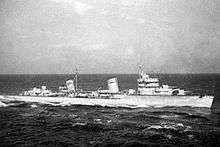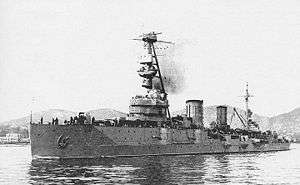Black Sea campaigns (1941–44)
| Black Sea Campaigns | |||||||
|---|---|---|---|---|---|---|---|
| Part of the Eastern Front of World War II | |||||||
 Soviet battleship Sevastopol (Parizhskaya Kommuna) | |||||||
| |||||||
| Belligerents | |||||||
|
|
| ||||||
| Commanders and leaders | |||||||
|
|
| ||||||
| Strength | |||||||
|
4 destroyers 12 torpedo boats 4 gunboats 3 submarines 2 Minelayers 4 torpedo boats 6 German Type II submarines 10 S-boats 23 R boats 4 MAS 6 Midget submarines 12 submarine chasers 47 patrol ships |
1 battleship 5 cruisers 18 destroyers 44 submarines 2 gunboats 18 minelayers 84 torpedo boats | ||||||
The Black Sea Campaigns were the operations of the Axis and Soviet naval forces in the Black Sea and its coastal regions during World War II between 1941 and 1944, including in support of the land forces.
The Black Sea Fleet was as surprised by Operation Barbarossa as the rest of the Soviet Military. The Axis forces in the Black Sea consisted of the Romanian and Bulgarian Navies together with German and Italian units transported to the area via rail and Canal. Although the Soviets enjoyed an overwhelming superiority in surface ships over the Axis, this was effectively negated by German air superiority and most of the Soviet ships sunk were destroyed by bombing. For the majority of the war, the Black Sea Fleet was commanded by Vice Admiral Filipp Oktyabrskiy, its other commander being Lev Vladimirsky.
All of the major Soviet shipyards were located in the Ukraine (Nikolayev) and Crimea (Sevastopol) and were occupied in 1941. Many incomplete ships which were afloat were evacuated to harbors in Georgia which provided the main bases for the surviving fleet. These ports such as Poti, however had very limited repair facilities which significantly reduced the operational capability of the Soviet Fleet.
Soviet naval strength
On 22 June 1941, the Black Sea Fleet of the Soviet Navy consisted of:
| Ship Type | Number | Note/class |
|---|---|---|
| Battleship | 1 | Parizhskaya Kommuna |
| Cruisers | 5 | Molotov, Voroshilov, Chervona Ukraina, Krasnyi Krym and Krasny Kavkaz |
| Destroyer Leaders | 3 | Leningrad-class destroyer and Tashkent-class destroyer |
| Destroyers (modern) | 11 | 6 Type 7, 5 Type 7U, |
| Destroyers (old) | 4 | Novik type |
| Submarines | 44 | |
| Escort vessels/gunboats | 2 | |
| Mine warfare vessels | 18 | |
| Motor torpedo boats | 84 |
Axis naval strength
Romanian Navy
The Royal Romanian Navy consisted of four destroyers, twelve torpedo boats, four gunboats, six minelayers, three amphibious landing self-propelled barges, four submarine chasers, three submarines and five midget submarines:[2]

| Ship Type | Number | Note/class |
|---|---|---|
| Destroyers | 4 | Mărăști class: Mărăști and Mărășești; Regele Ferdinand class: Regele Ferdinand and Regina Maria |
| Gunboats | 4 | C class: Dumitrescu, Ghiculescu, Lepri and Stihi |
| Minelayers | 2 | Aurora; Amiral Murgescu |
| Submarines | 3 | Delfinul; Rechinul; Marsuinul |
| Midget submarines | 5 | CB class |
| Submarine tenders | 1 | Constanța |
Bulgarian Navy
Despite Bulgaria's neutral status in the German-Soviet war, the Bulgarian navy was involved in escort duties to protect Axis shipping against Soviet submarines in Bulgarian territorial waters. The small Bulgarian navy consisted of 4 old torpedo boats, various motor torpedo boats, patrol boats, minelayers, minesweepers and other light craft.
Germany

As Turkey was neutral during World War II, the Axis could not transfer warships to the Black Sea via the Bosphorus. However, several small ships were transferred from the North Sea via rail, street and canal networks to the Danube. These included six Type IIB U-boats of the 30th U-boat Flotilla which were dis-assembled and shipped to Romania along the Danube. They were then re-assembled at the Romanian Galați shipyard in late 1942 and afterwards sent to Constanța. The Germans also transported 10 S-boats (Schnellboote) and 23 R-boats (Räumboote) via the Danube and built armed barges and KTs ( kriegstransporter, literally war transports ) in the captured Nikolayev Shipyards in Mykolaiv. Some ships were obtained in Romania, Bulgaria and Hungary, and then converted to serve the German cause, such as the S-boat tender Romania, the minelayer Xanten and the Anti-submarine trawler UJ-115 Rosita. Additional vessels were built in German or local shipyards, captured from Soviets, or transferred from the Mediterranean nominally as merchant ships. The German Black Sea fleet ultimately operated hundreds of medium and small warships or auxiliaries before its self-destruction immediately prior to the defection of Bulgaria. Very few vessels were able to make good their escape via the Danube.
Italy
The Italian Regia Marina (Royal Navy) dispatched a small force to the Black Sea. The force dispatched included six CB class midget submarines and a flotilla of Torpedo Armed Motorboats (Motoscafo Armato Silurante, or MAS). The MAS were commanded by Francesco Mimbelli and were based in Yalta.
Hungarian Merchant Navy
Hungary became landlocked in the aftermath of World War I, but some Hungarian merchant ships were able to reach the black sea via the Danube River. Hungarian cargo ships like the Kassa and Budapest were operated as part of Axis sea transport forces on the Black Sea, and thus participated in the Axis evacuation from Crimea.
Croatian Naval Legion
The Croatian Naval Legion was formed in July 1941. It was initially comprised some 350 officers and ratings in German uniform, but this eventually swelled to 900–1,000. Their first commander was Andro Vrkljan, later replaced by Stjepan Rumenović. The Croats' purpose in posting a naval contingent to the Black Sea was to evade the prohibition on an Adriatic navy imposed by the 18 May 1940 Treaty of Rome with Italy. This prohibition effectively limited the Croatian Navy (RMNDH) to a riverine flotilla. Upon its arrival at the Sea of Azov, managed to scrounge up 47 damaged or abandoned fishing vessels, mostly sailing ships, and to man them hired local Russian and Ukrainian sailors, many deserters from the Soviet Navy. The Legion later acquired 12 German submarine hunters and a battery of coastal artillery. Lieutenant Josip Mažuranić notably commanded the submarine hunter UJ2303.[3]
Operations in 1941

On June 26 the Soviet forces attacked Romanian city of Constanța. During this operation, the destroyer leader Moskva was lost to mines while evading fire from coastal batteries. The Black Sea Fleet supplied the besieged garrison in Odessa and evacuated a significant part of the force (86,000 soldiers, 150,000 civilians) at the end of October, but lost the destroyer Frunze and a gunboat to the German dive bombers in the process. The Black Sea Fleet played a valuable part in defeating the initial assault on Sevastopol. In December, there was an amphibious operation against Kerch which resulted in the recapture of the Kerch Peninsula. A naval detachment including the cruiser Krasnyi Krym remained in Sevastopol to give gunfire support. Soviet submarines also raided Axis shipping on the Romanian and Bulgarian coasts, sinking 29,000 long tons (29,000 t) of shipping. During fall of 1941, both sides laid many mine fields in southern Black Sea: Romanian defensive minefields sunk at least 5 Soviet submarines during this period (M-58,[4] S-34,[5] ShCh-211,[6] M-34,[7] M-59[8]), however during such operations the Axis forces lost the Romanian minelayer Regele Carol I,[9] sunk by a mine laid by Soviet submarine L-4: 2 of the 5 Soviet submarines (M-58 and ShCh-211) will be later sunk on that same minelayer's fields, after the sinking of the ship, in addition to another submarine sunk in 1942. In total, up to 15 Soviet submarines were sunk by Romanian defensive minefields until the end of the War.[10] Another Romanian minelayer was lost, the Aurora, when the ship was destroyed by Soviet bombers on 15 July.[11]
Operations in 1942

Operations in 1942 were dominated by the Siege of Sevastopol. During the winter, Soviet warships including the only battleship Parizhskaya Kommuna provided fire support and supply missions near Sevastopol. The Soviets continued supply missions until 27 June, losses were heavy and included the cruiser Chervonnaya Ukraina, destroyer leader Tashkent and six modern destroyers.
The cruiser Voroshilov and destroyers tried to intervene without success in the Battle of the Kerch Peninsula in May and the Soviets could not prevent a landing across the Kerch strait in the Taman Peninsula in September. The remainder of the Black Sea Fleet evacuated to ports in the Caucasus that had very limited facilities. Soviet submarines were active in the western part of the Black Sea where they attacked Axis shipping. Unfortunately this included sinking the refugee ship Struma. On 1 October the Soviet submarine M-118 was sunk with depth charges by the Romanian gunboat Sublocotenent Ghiculescu.[12]
Operations in 1943

In 1943, the Black Sea Fleet was reduced to the following ships, which all suffered from poor maintenance due to a lack of facilities:
- Battleship Sevastopol
- Four cruisers (two Kirov class - Molotov and Voroshilov -, Krasniy Krim and Krasniy Kavkaz)
- Destroyer leader Kharkov
- Five modern and three old destroyers
- 29 submarines
Operations initially consisted of several offensive operations by the Soviets including the defence of Malaya Zemlya in Novorossiysk and some coastal bombardments and raids. On 7 July, the Romanian destroyer Mărășești sank the Soviet submarine M-31.[13] As the war was going badly for the Axis on other fronts, the Germans began to evacuate the Kuban bridgehead in September. This was successfully accomplished. Kharkov and two destroyers—Sposobny and Besposchadny—were sunk by Stukas while raiding the Crimea. As a result of this loss, Stalin insisted on personally authorizing the use of any large ships. The Kerch-Eltigen Operation followed in November.
Operations in 1944

By early 1944, the Soviet surface fleet was practically nonoperational due to a poor state of repair. Most of the offensive work was carried out by small vessels and the Soviet Naval air force. The land situation had significantly deteriorated for the Axis. The area around Odessa was liberated in March trapping the Axis forces in the Crimea. The last Axis forces near Sevastopol surrendered on 9 May 1944 and a considerable number of men were evacuated. (See Battle of the Crimea (1944) for details). Soviet submarines continued to attack Axis shipping. Unbeknownst to them, one of the ships attacks was MV Mefküre transporting Jewish refugees from Europe.
On 20 August 1944, the Red Air Force carried on a large air raid against the main Axis base in Black Sea. A number of targets were sunk including the German U-boat U-9,[14] and the old Romanian torpedo boat Naluca.[15] U-18[16] and U-24 [17] were both damaged and were scuttled few days later. The Naval war in Black Sea was now almost over, but U-boats remained operative until they consumed their fuel: with a single strike, Soviet aviation had halved the German submarine force, but the effect could have been greater if such an attack had been carried out earlier.
See also
References
- ↑ http://www.worldwar2.ro/arr/?article=776
- ↑ "10 lucruri de știut despre ... Submarinele românești | Historia". Historia.ro. Retrieved 2014-03-08.
- ↑ Andro Vrkljan (2011). Hrvatski Argonauti 20. stoljeća: Povijest Hrvatske pomorske legije na Crnom moru 1941. - 1944. Hrvatski Državni Arhiv. ISBN 978-953-7659-07-3.
- ↑ http://uboat.net/allies/warships/ship/4930.html
- ↑ http://www.uboat.net/allies/warships/ship/5106.html
- ↑ http://uboat.net/allies/warships/ship/5042.html
- ↑ http://uboat.net/allies/warships/ship/4949.html
- ↑ http://uboat.net/allies/warships/ship/4931.html
- ↑ http://www.worldwar2.ro/arr/?article=253
- ↑ Definitive list of Black Sea Fleet submarines
- ↑ http://www.worldwar2.ro/arme/?article=255
- ↑ World War II Sea War, Volume 7: The Allies Strike Back, p. 179
- ↑ M. J. Whitley, Destroyers of World War Two, p. 224
- ↑ http://www.uboat.net/boats/u9.htm
- ↑ http://www.navypedia.org/ships/romania/ro_dd_naluca.htm
- ↑ http://www.uboat.net/boats/u18.htm
- ↑ http://www.uboat.net/boats/u24.htm
Bibliography
- Ruge, Fredrich - The Soviets as Naval Opponents, 1941-1975 (1979), Naval Press Annapolis ISBN 9780870216763